Materials and Techniques of Selected Mural Paintings on the “Gothic Road” around 1400 (Slovakia)
Abstract
:1. Introduction
2. Objectives
3. Materials and Methods
4. Results and Discussion
4.1. Plešivec
4.1.1. Plaster
4.1.2. Preliminary Paintings Procedures
4.1.3. Materials and Techniques
4.1.4. Colour Modelling
4.2. Chyžné
4.2.1. Plaster
4.2.2. Preliminary Paintings Procedures
4.2.3. Materials and Techniques
4.2.4. Colour Modelling
4.3. Štítnik
4.3.1. Plaster
4.3.2. Preliminary Paintings Procedures
4.3.3. Materials and Techniques
4.3.4. Colour Modelling
5. Conclusions
Author Contributions
Funding
Acknowledgments
Conflicts of Interest
References
- Dvořáková, V.; Fodor, P.; Stejskal, K.K. Vývoji středovĕké nástĕnné malby v oblasti Gemerské a Malohonstké. Umení 1958, 6, 344–352. [Google Scholar]
- Togner, M. Stredoveká Nástenná Maľba na Slovensku. Súčasný Stav Poznania; Tatran: Bratislava, Slovakia, 1988. [Google Scholar]
- Togner, M. Stredoveká Nástenná maľba v Gemeri; Tatran: Bratislava, Slovakia, 1989. [Google Scholar]
- Plekanec, V.; Haviar, T. Gotický Gemer a Malohont. Italianizmy v Stredovekej Nástennej Maľbe/ Gotrhic Gemer and Malohont. Italianizing in Medieval Wall Painting; VMS, Arte Libris: Bratislava, Slovakia, 2010. [Google Scholar]
- Prokopp, M. Italian Trecento Influence on Murals in East Central Europe Particularly Hungary; Akademiai Kiadó: Budapest, Hungary, 1983. [Google Scholar]
- Togner, M. Recepcia a transformácia. Slovensko a Taliansko v stredoveku. K percepcii trecentnych italizmov v stredovekej nástennej maľbe na Slovensku. In Problémy Dejín Výtvarného Umenia Slovenska; Bakoš, J., Madarásová, J., Umenia, U.D., Eds.; Veda: Bratislava, Slovakia, 2002; p. 70. [Google Scholar]
- Mairinger, F. Naturwissenschaftliche Untersuchungen an Wandmalereien, Historische Technologie und Konservierung von Wandmalerei; Verlag Paul Haupt: Bern, Switzerland; Stuttgart, Gerrmany, 1985. [Google Scholar]
- Palazzi, S. Analisi Chimica per L’arte e il Restauro: Principi, Tecniche, Applicazioni; Nardini Editoriale: Fiesole, Italy, 1997. [Google Scholar]
- Volpin, S.; Appolonia, L. Le Análisis di Laboratorio Aplícate ai Beni Artistici Policromi; Il Prato: Padova, Italy, 2002. [Google Scholar]
- Matteini, M.; Moles, A. Scienza e Restauro: Metodi d´Indagine; Nardini: Firenze, Italy, 2002. [Google Scholar]
- Artioli, G. Scientific Methods and Cultural Heritage: An Introduction to the Application of Materials Science to Archaeometry and Conservation Science; Oxford University Press: Oxford, NY, USA; Great Britain, UK, 2010. [Google Scholar]
- Clementi, C.; Ciocan, V.; Vagnini, M.; Doherty, B.; Laurenzi Tabasso, M.; Conti, C.; Brunetti, B.G.; Millani, C. Non-invasive and micro-destructive investigation of the Domus Aurea wall paintings decorations Anal. Bioanal. Chem. 2011, 401, 1815–1826. [Google Scholar] [CrossRef]
- De Benedetto, G.; Fico, D.; Margapoti, E.; Pennetta, A.; Cassiano, A.; Minerva, B. The study of the mural painting in the 12th century monastery o Santa Maria delle Cerrate (Puglia-Italy): Characterization of materials and techniques used. J. Raman Spectrosc. 2013, 44, 899–904. [Google Scholar] [CrossRef]
- Constantini, I.; Castro, K.; Madariaga, J.M. Portable and laboratory analytical instruments for the study of materials, techniques and environmental impacts in mediaeval mural paintings. Anal. Methods 2018, 10, 4854–5870. [Google Scholar] [CrossRef]
- Regazzoni, L.; Cavallo, G.; Biondelli, D.; Gilardi, J. Microscopic analysis of wall painting techniques: Laboratory replicas and romanesque case studies in Southern Switzerland. Stud. Conserv. 2018, 63, 326–341. [Google Scholar] [CrossRef]
- Botticell, G. Tecnica e Restauro delle Pitture Murali; Polistampa: Firenze, Italy, 1980; p. 32. [Google Scholar]
- Knoepfli, A.; Emmeneger, O.; Koller, M.; Meyer, A. Reclams Handbuch der künstlerischen Techniken. Wandmalerei, Mosaik, II; Philipp Reclam jun: Stuttgart, Germany, 1990; pp. 79–80. [Google Scholar]
- Ilg, A. (Ed.) Theophilus. In Schedula Diversarum Artium; Braumüller Verlag: Wien, Austria, 1874; pp. 18–19, 32–33, 38–39. [Google Scholar]
- Cennini, C. Il Libro Dell’arte; Serchi, M., Ed.; Felice le Monier: Firenze, Italy, 1999. [Google Scholar]
- Eibner, A. Entwicklung und Werkstoffe der Wandmalerei vom Altertum bis zur Neuzeit; Ständig Reprint: München, Germany, 1970. [Google Scholar]
- Montagna, G. I pigmenti, Prontuario per L’arte e il Restauro; Nardini: Firenze, Italy, 1993. [Google Scholar]
- Brachert, T. Lexikon Historischer Maltechniken, Quellen—Handwerk—Technologie—Alchemie; Callwey: München, Germany, 2001. [Google Scholar]
- Mora, P.; Mora, L.; Philippot, P. La Conservazione delle Pitture Murali; Editrice Compositori: Bologna, Italy, 2001. [Google Scholar]
- Howard, H. Pigments of English Medeal Wall Panting; Archtype Publication: London, UK, 2003. [Google Scholar]
- Želinská, J.; Novotná, M.; Klučková, E. Štúdia k technologickej výstavbe gotických krídlových oltárov z kostola Sv. Jakuba v Levoči, Slovensko. In Acta Artis Academica, Proceedings of the 4th Interdisciplinary ALMA Conference “Knowledge and Experience in the Fine Art. From Understanding Materials to Technological Applications”, Prague, Czech, 21–23 November 2012; Hradil, D., Hradilová, J., Eds.; Academy of Fine Arts: Prague, Czech Republic, 2012; pp. 87–90. [Google Scholar]
- Analyza Vzoriek z Nastennej Mal’by z Rimskokatolíckeho Kostola Zvestovania Panny Márie v Chyžnom; Report 40/17A-1, PUSR-2017/19331-1/67002/ZEL; Chemical-technological department, Monuments Board of RS: Bratislava, Slovakia, 2017; p. 9.
- Jones, B. Malachite Morphology, I. In Rock&Gem Magazine; Available online: https://www.rockngem.com/malachite-morphology/ (accessed on 23 August 2021).
- Hradil, D.; Hradilová, J.; Bezdička, P.; Švarcová, S. Provenance study of Gothic paintings from North-East Slovakia by handheld x-ray fluorescence, microscopy and x-ray microdiffraction. X-Ray Spectrom. 2008, 37, 376–382. [Google Scholar] [CrossRef]
- Feller, R.L.; Roy, A.; West Fitzhugh, E.; Berrie, B. (Eds.) Artist’s Pigments. A Handbook of Their History and Characteristics; National Gallery of Art, Washington, Archetype Publications: London, UK, 2012; Volumes 1–4. [Google Scholar]
- Eastaugh, N.; Walsh, V.; Chaplin, T.; Siddall, R. Pigment Compendium, A Dictionary of Historical Pigments; Routledge: London, UK, 2004. [Google Scholar]
- Coccato, A.; Moens, L.; Vandenabeele, P. On the stability of mediaeval inorganic pigments: A literature review of the effect of climate, material selection, biological activity, analysis and conservation treatments. Herit. Sci. 2017, 5, 1–25. [Google Scholar] [CrossRef] [Green Version]
- Pique, F.; Caroselli, M.; Koch Dandolo, C.L.; Luppichini, S.; Santella, M. Multitechnical approach for the characterization of the stratigraphy of blue areas in wall paintings in the chapel 11 at the Sacro Monte di Varallo, Italy. Int. J. Conserv. 2016, 7, 945–954. [Google Scholar]
- Azé, S.; Vallet, J.M.; Pomey, M.; Baronnet, A.; Grauby, O. Red led darkening in wall paintings: Natural ageing of experimental wall paintings versus artificial ageing tests, Eur. J. Minreal. 2007, 19, 883–890. [Google Scholar]
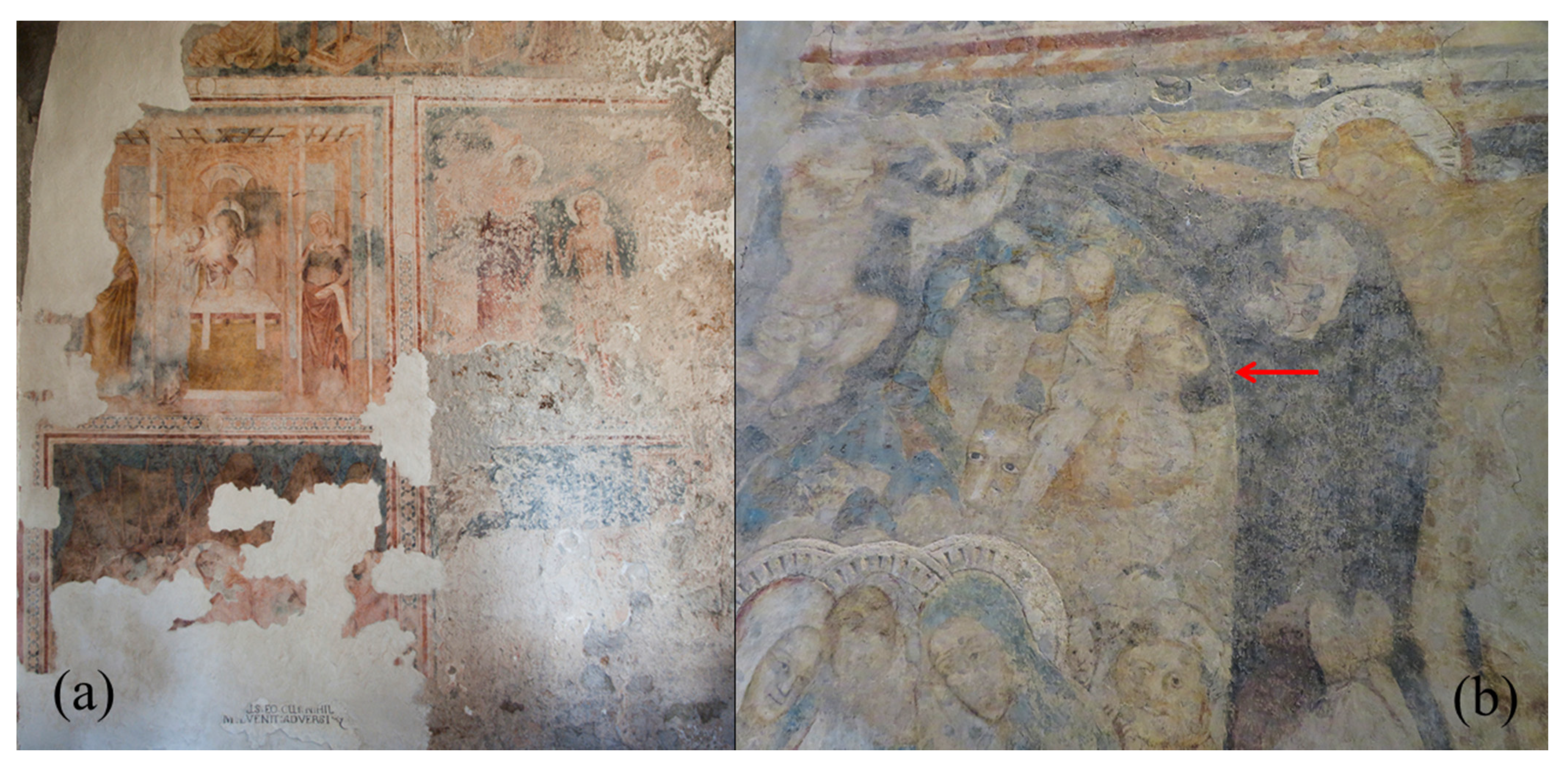
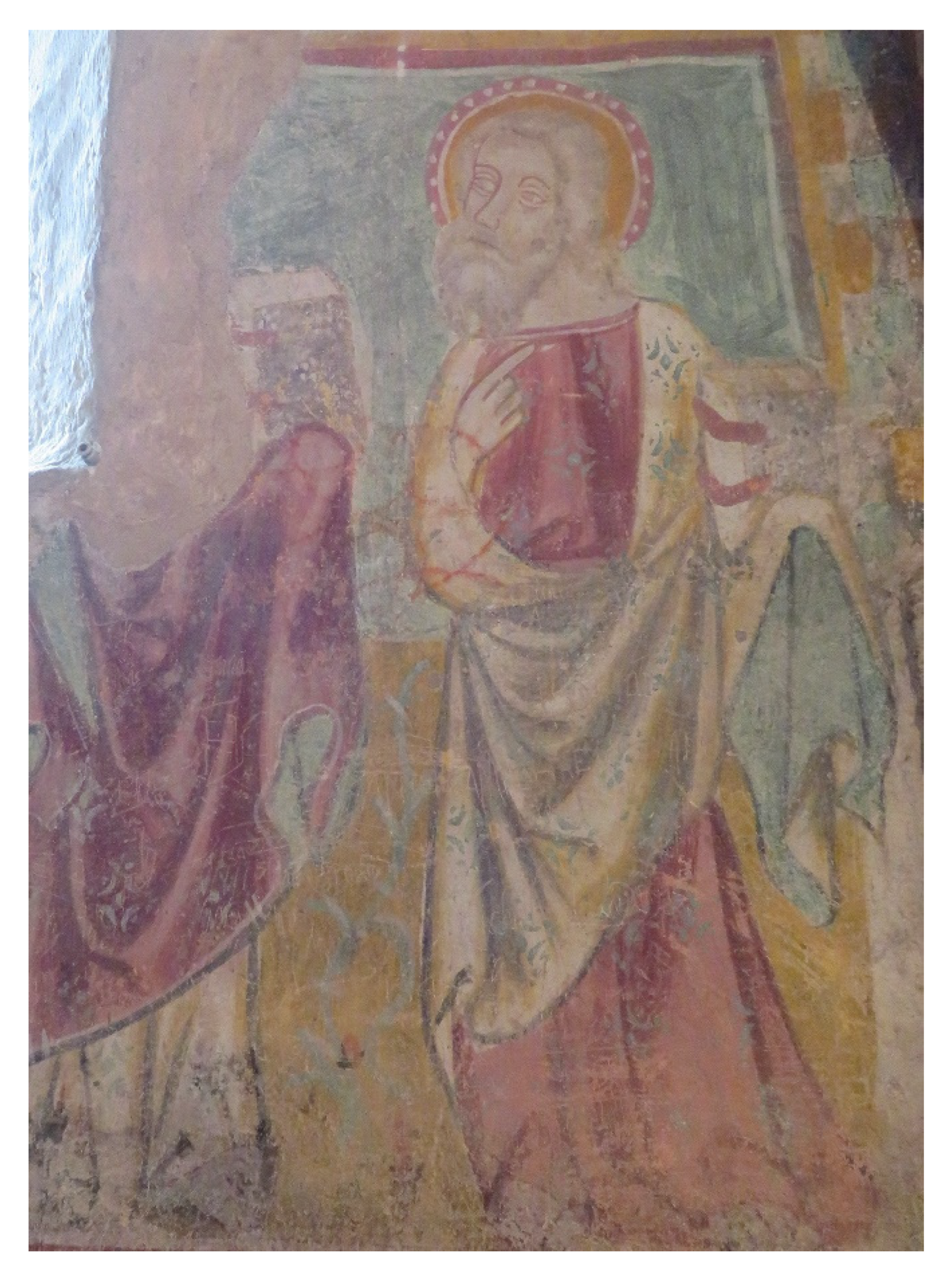


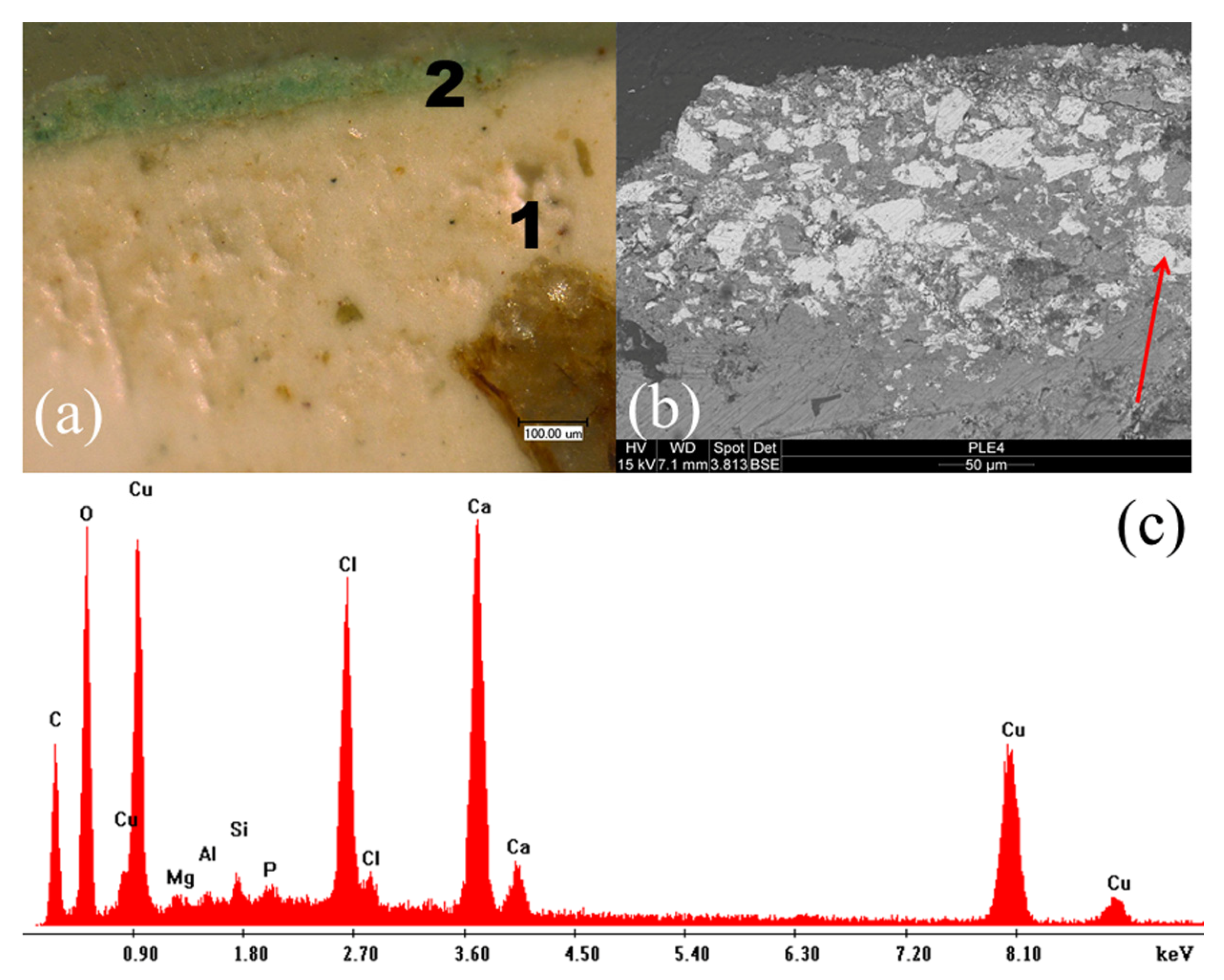
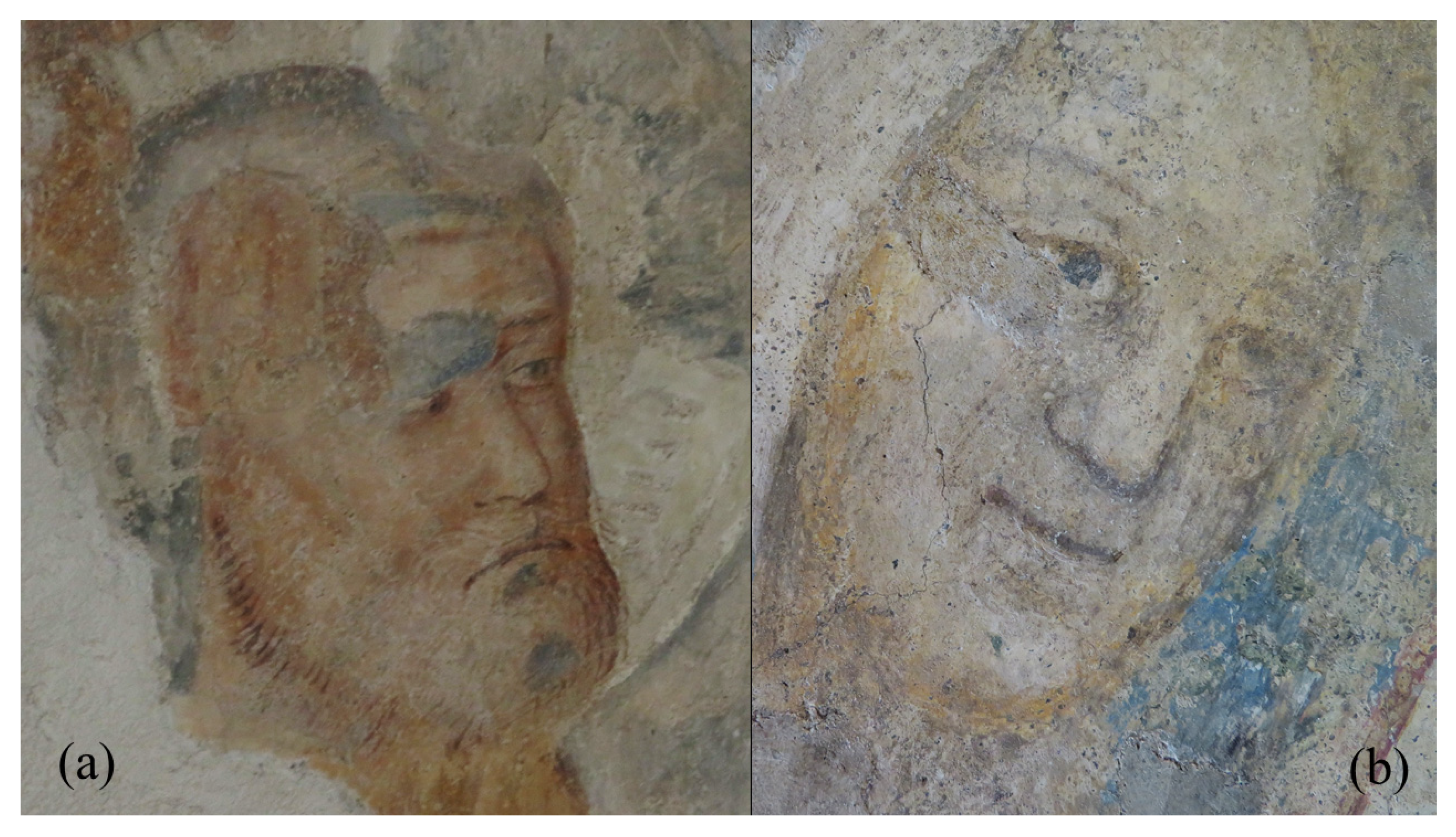

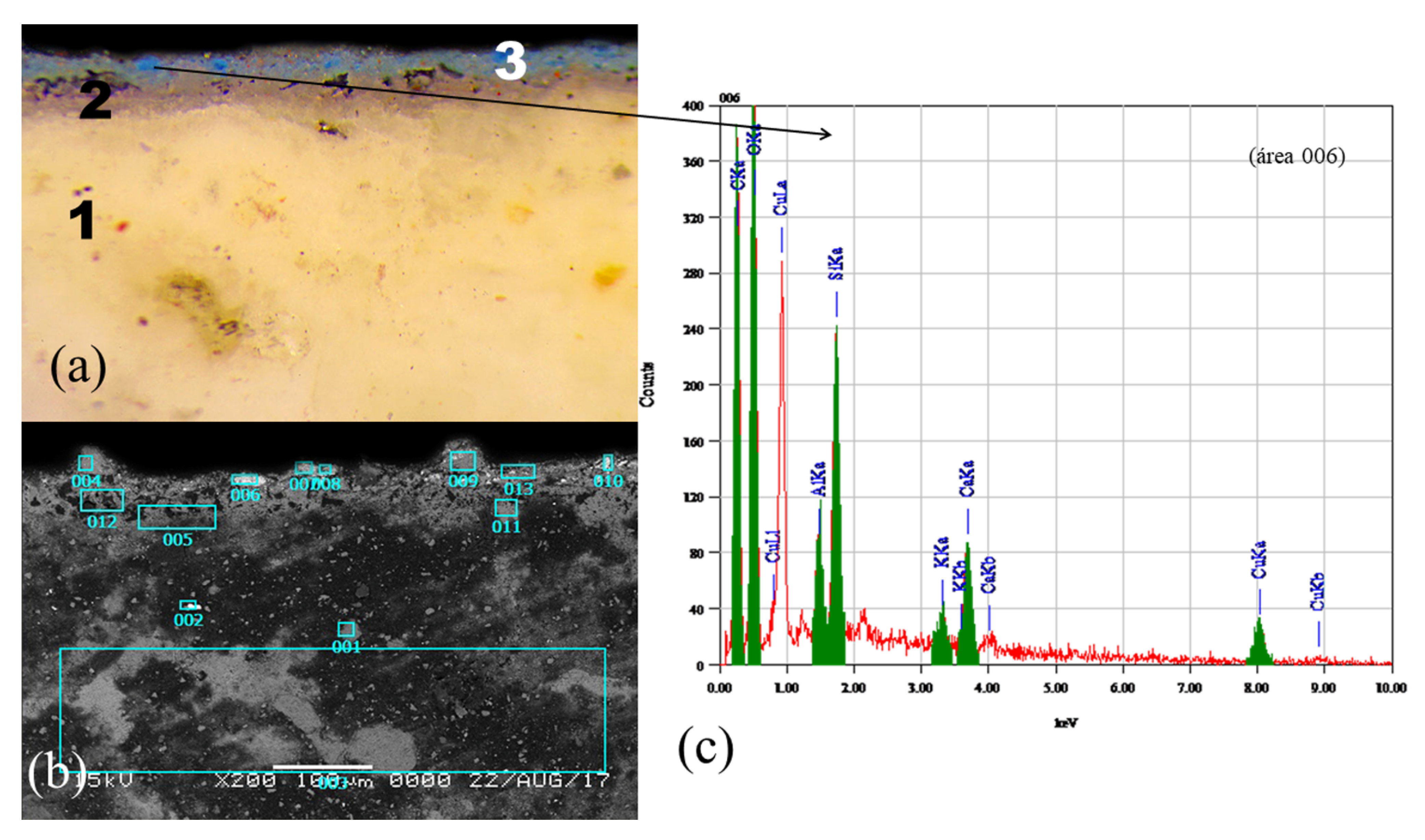
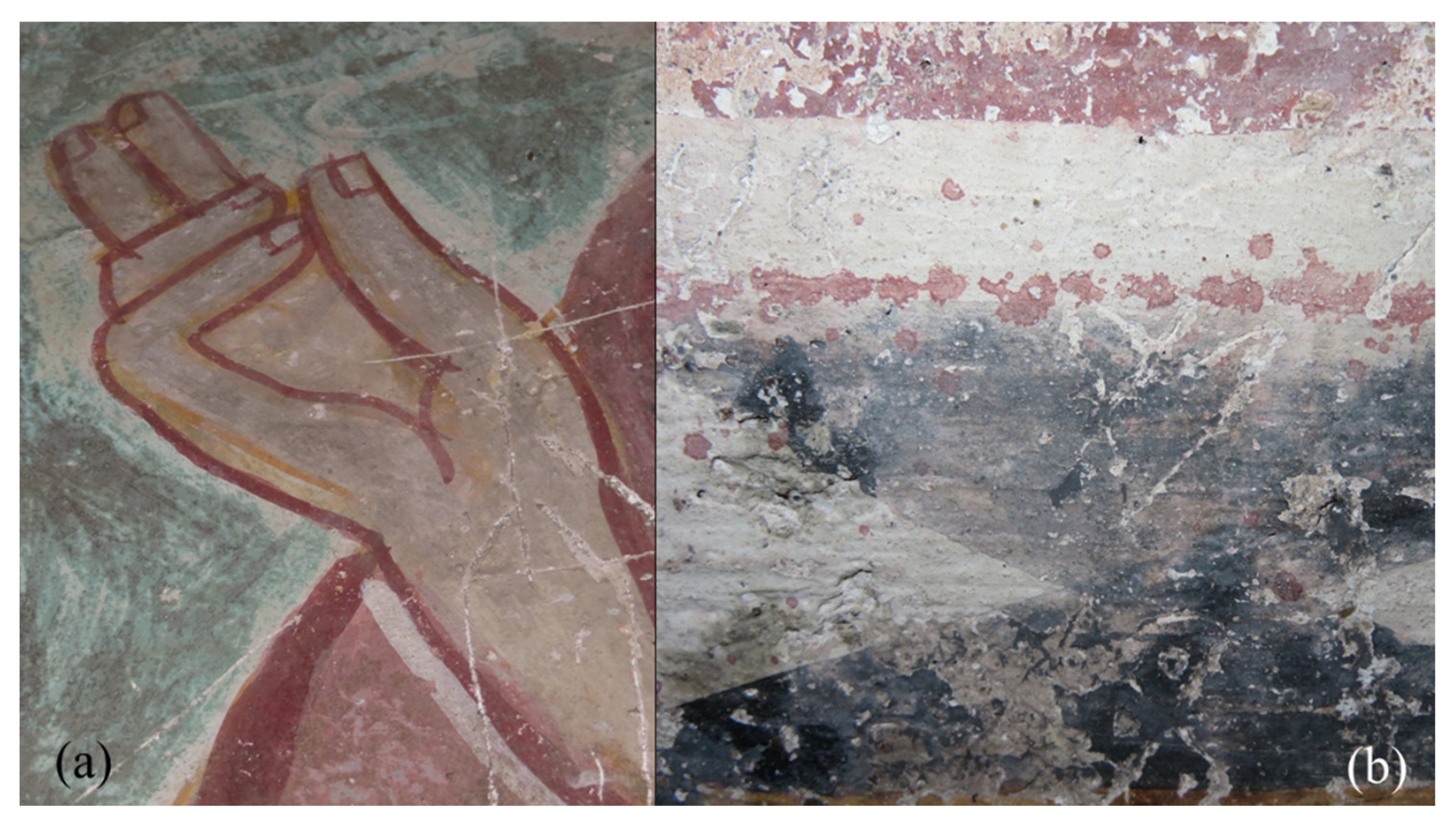
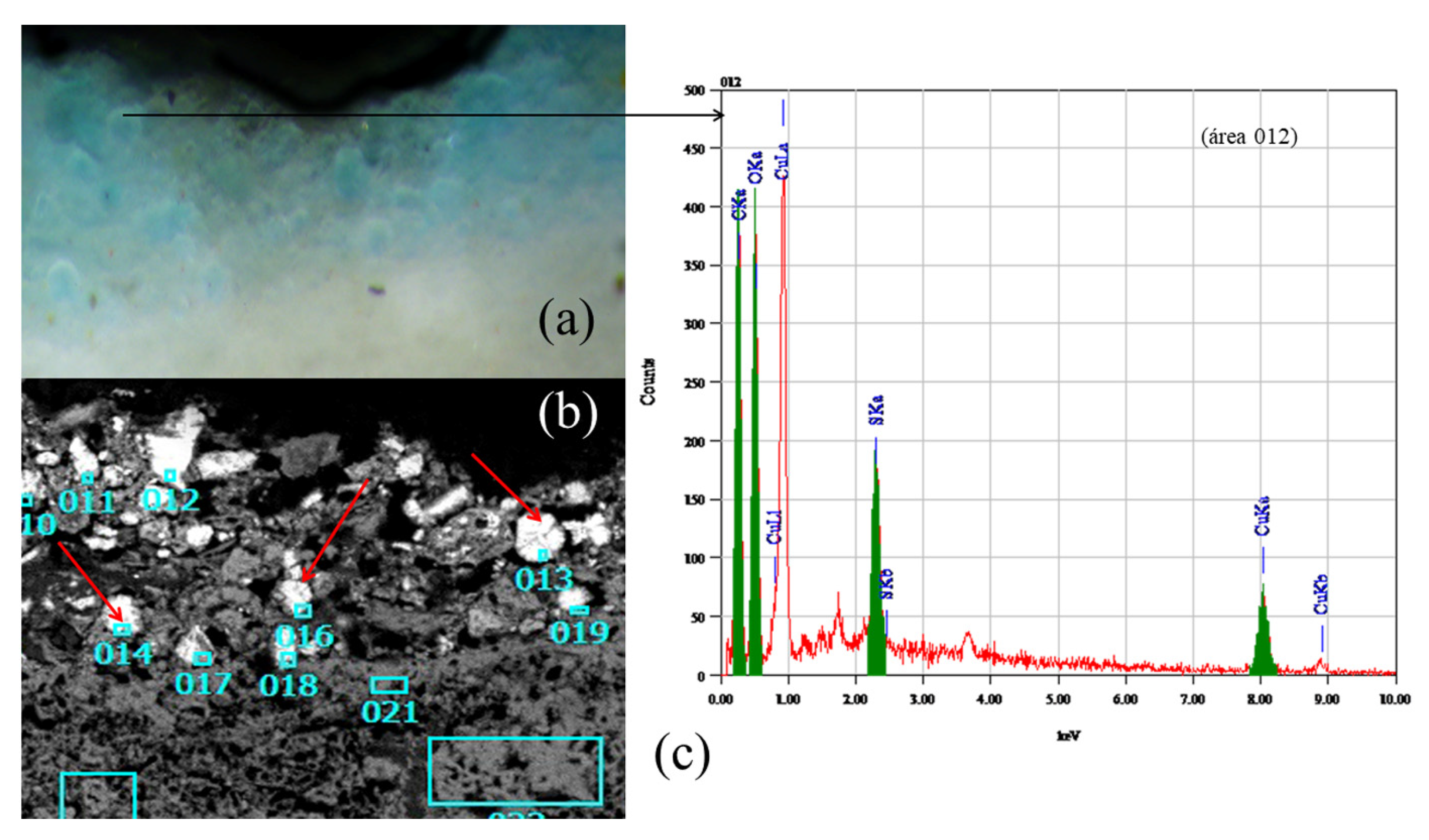
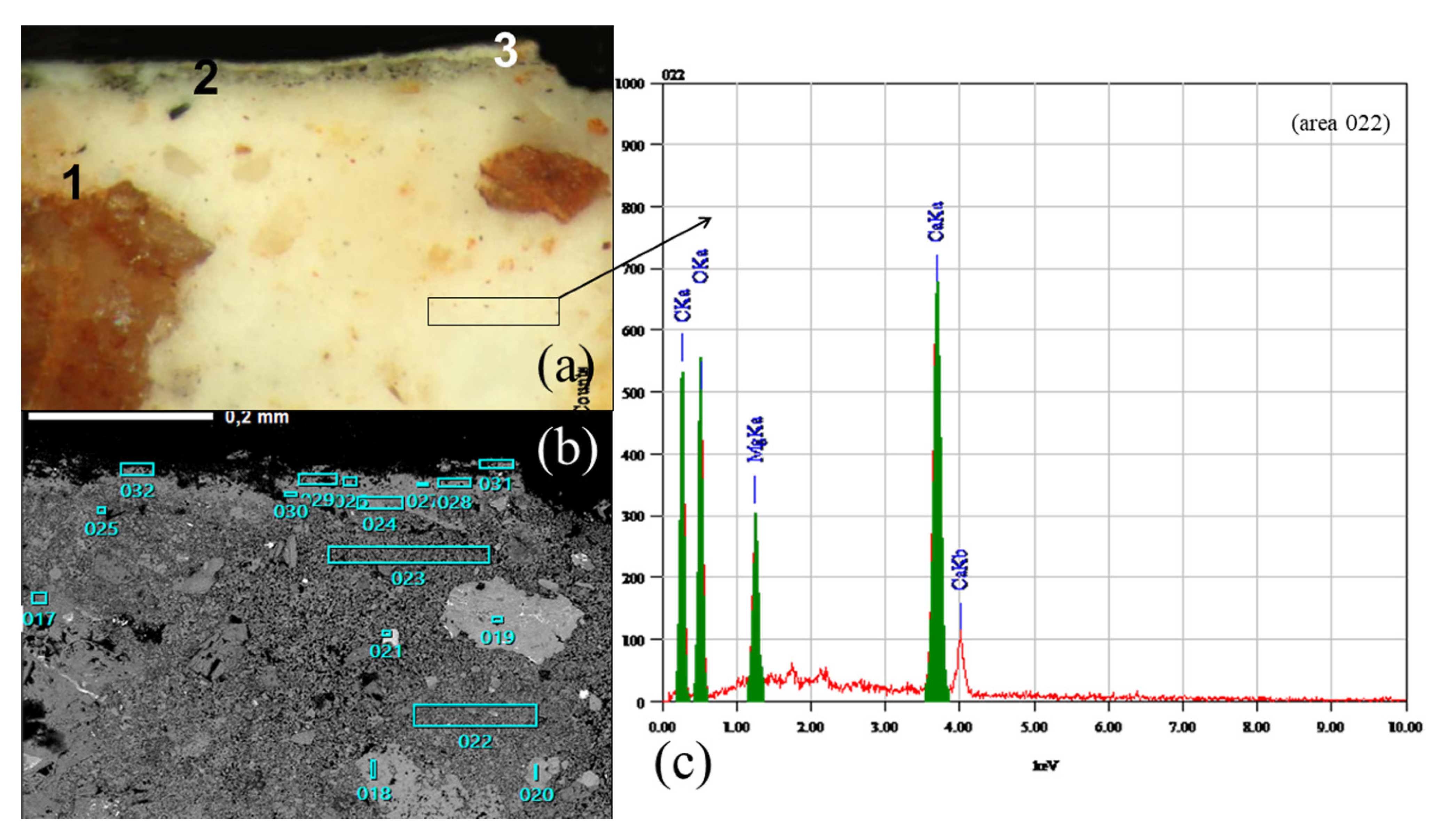
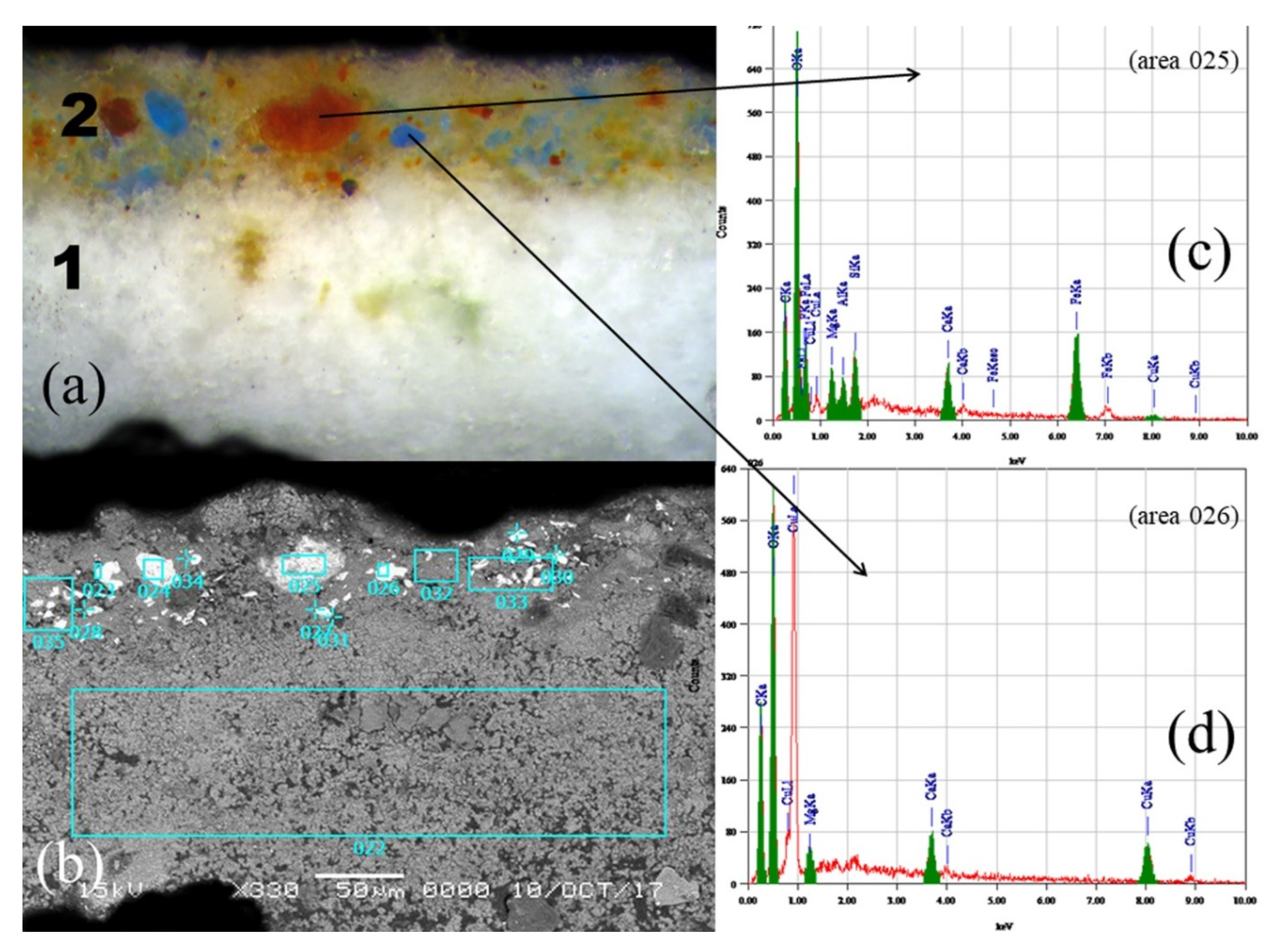

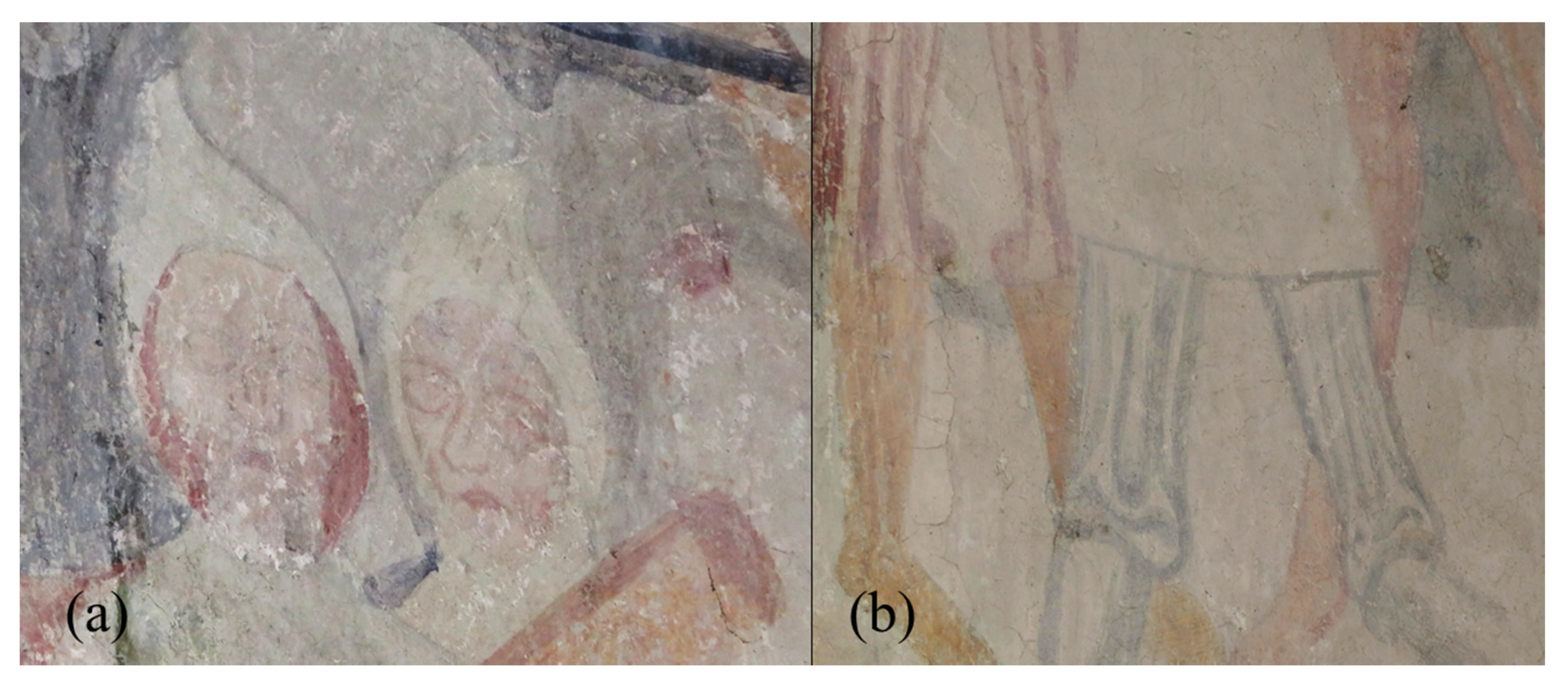
| Chyzne 7 | C | O | Mg | Al | Si | K | Ca | Fe |
|---|---|---|---|---|---|---|---|---|
| 1 | 30.61 | 22.15 | 3.71 | 1.01 | 2.49 | - | 40.03 | - |
| 2 | 32.39 | 27.29 | 1.93 | 7.8 | 10.64 | 2.14 | 12.51 | 5.3 |
| 3 | 45.22 | 20.28 | 3.03 | 3.57 | 6.51 | 1.02 | 14.58 | 5.78 |
| 4 | 41.2 | 20.41 | 1.58 | 2.7 | 5.63 | - | 21.24 | 7.25 |
| 5 | 41.39 | 18.59 | 0.94 | 1.72 | 3.24 | - | 26.37 | 7.74 |
| 6 | 30.83 | 19.89 | 1.41 | 1.12 | 2.59 | - | 20.91 | 23.25 |
| 7 | 30.35 | 23 | 2.11 | 1.49 | 5.66 | - | 27.72 | 9.66 |
| 8 | 41.75 | 19.53 | 1.64 | 2.7 | 4 | - | 24.67 | 5.7 |
| 9 | 42.61 | 23.39 | 1.91 | 6.63 | 9.29 | - | 9.09 | 7.07 |
| 10 | 42.1 | 18.89 | 1.19 | 2.24 | 3.83 | - | 23.54 | 8.21 |
| 11 | 51.05 | 21.05 | - | 4.73 | 11.33 | 2.77 | 6.86 | 2.21 |
| 12 | 40.7 | 20.78 | 1.4 | 3.55 | 5.8 | 1.21 | 19.88 | 6.67 |
| 13 | 52.92 | 17.94 | 0.62 | 1.35 | 7.7 | 1.09 | 18.39 | - |
| 14 | 73.95 | 9.14 | 1.19 | 0.84 | 2.69 | 1.67 | 10.53 | - |
| 15 | 36.38 | 23.31 | 2.02 | 3.02 | 8.17 | - | 19.75 | 7.35 |
| Chyzne 9 | C | O | Mg | Al | Si | K | Ca | Fe | Cu |
|---|---|---|---|---|---|---|---|---|---|
| 1 | 43.32 | 29.52 | - | - | 25.24 | - | 1.92 | - | - |
| 2 | 52.82 | 17.12 | 0.59 | 0.87 | 8.53 | - | 4.38 | 15.7 | - |
| 3 | 50.82 | 18.54 | 1.62 | 0.8 | 7.43 | - | 20.8 | - | - |
| 4 | 40.2 | 29.42 | - | 2 | 22.55 | 1.92 | 3.92 | - | - |
| 5 | 49.21 | 16.38 | 1.04 | - | 3.2 | - | 30.17 | - | - |
| 6 | 44.63 | 18.21 | - | 2.72 | 7.07 | 1.48 | 6.16 | - | 19.73 |
| 7 | 45.48 | 17.81 | 0.97 | 1.68 | 6.07 | 1.23 | 11.27 | 2.9 | 12.59 |
| 8 | 53.32 | 15.5 | - | 2.56 | 5.21 | 1.3 | 9.84 | - | 12.26 |
| 9 | 38.54 | 30.23 | - | 2.06 | 23.44 | 1.19 | 2.02 | - | 2.52 |
| 10 | 48.73 | 14.69 | 0.65 | 1.75 | 2.69 | - | 11.64 | - | 19.84 |
| 11 | 38.86 | 19.64 | - | - | 4.16 | - | 37.34 | - | - |
| 12 | 59.28 | 12.5 | - | - | 1.68 | - | 26.54 | - | - |
| 13 | 53.04 | 16.82 | - | 1.57 | 6.6 | 1.23 | 16.54 | - | 4.2 |
| Chyzne 10 | C | O | Mg | Al | Si | S | Cl | Ca | Cu |
|---|---|---|---|---|---|---|---|---|---|
| 10 | 37.61 | 14.87 | 2.88 | - | 1.39 | - | - | 3.44 | 39.81 |
| 11 | 39.42 | 13.08 | 1.88 | - | - | - | - | 2.44 | 43.17 |
| 12 | 43.03 | 16.81 | - | - | - | 5.38 | - | - | 34.78 |
| 13 | 34.93 | 14.92 | 1.65 | - | 1.5 | - | - | 1.99 | 45.01 |
| 14 | 41.69 | 15.11 | 1.92 | 1.43 | 2.21 | - | - | 3.95 | 33.69 |
| 15 | 31.16 | 15.58 | 1.04 | 0.76 | 0.92 | - | - | 3.02 | 47.51 |
| 16 | 32.51 | 16.05 | 1.72 | 1.1 | 1.55 | - | - | 2.16 | 44.91 |
| 17 | 33.19 | 16.94 | 2.56 | 1.35 | 2.23 | - | - | 3.43 | 40.3 |
| 18 | 29.74 | 15.79 | 1.15 | - | 0.93 | - | - | 5.3 | 47.1 |
| 19 | 34.63 | 15.18 | 2.53 | - | 1.25 | - | - | 2.75 | 43.67 |
| 20 | 36.64 | 18.82 | 4.01 | - | - | - | - | 40.54 | - |
| 21 | 26.45 | 21.92 | 1.78 | - | 1.14 | - | - | 48.71 | - |
| 22 | 37.69 | 19.25 | 4.12 | - | 1.34 | - | - | 37.6 | - |
| Stitnik 11 | C (%) | O (%) | Na (%) | Mg (%) | Al (%) | Si (%) | P (%) | Ca (%) |
|---|---|---|---|---|---|---|---|---|
| 17 | 30.46 | 22.64 | - | 15.15 | - | - | - | 31.75 |
| 18 | 19.3 | 23.55 | - | 2.85 | - | - | - | 54.3 |
| 19 | 24.09 | 21.66 | - | - | - | - | - | 54.26 |
| 20 | 21.81 | 22.57 | - | 1.45 | - | - | - | 54.17 |
| 21 | 21.05 | 30.04 | - | 1.33 | - | - | 11.41 | 36.17 |
| 22 | 32.54 | 20.56 | - | 7.08 | - | - | - | 39.83 |
| 23 | 33.63 | 20.09 | - | 6.21 | - | - | - | 40.07 |
| 24 | 24.82 | 23.28 | - | 5.6 | - | 1.5 | - | 44.8 |
| 25 | 36.79 | 19.16 | - | 6.09 | - | - | - | 37.96 |
| 26 | 33.85 | 20.36 | 0.7 | 3.05 | - | 1.8 | - | 40.23 |
| 27 | 27.84 | 21.78 | - | 3.62 | - | 0.99 | - | 45.78 |
| 28 | 35.34 | 19.15 | - | 3.82 | - | - | - | 41.69 |
| 29 | 45.36 | 16.76 | - | 3.26 | - | 1.06 | - | 33.56 |
| 30 | 27.62 | 22.2 | - | 5 | - | 1.17 | - | 44.01 |
| 31 | 48.44 | 16.9 | - | 3.03 | 1.41 | 2.14 | - | 28.08 |
| 32 | 47.09 | 16.18 | - | 2.8 | - | 1.08 | - | 32.85 |
| Štítnik 12 | C | O | F | Mg | Al | Si | S | Ca | Fe | Cu | Ba |
|---|---|---|---|---|---|---|---|---|---|---|---|
| 22 | 39.83 | 18.29 | - | 3.49 | - | 0.9 | - | 37.5 | - | - | - |
| 23 | 25.29 | 18.33 | 1.53 | 2.17 | - | 1.71 | - | 4.04 | 43.97 | 2.95 | - |
| 24 | 42.4 | 13.02 | - | 1.98 | - | - | - | 6.69 | - | 35.91 | - |
| 25 | 22.77 | 20.68 | 1.99 | 2.63 | 1.67 | 2.99 | - | 5.63 | 38.05 | 3.57 | - |
| 26 | 36.6 | 13.88 | - | 1.56 | - | - | - | 5.32 | - | 42.63 | - |
| 27 | 20.65 | 20.09 | - | 2.36 | - | 2.15 | - | 4.37 | 47.84 | 2.54 | - |
| 28 | 28.4 | 16.27 | - | 1.11 | - | - | - | 12.36 | 2.08 | 39.78 | - |
| 29 | 18.69 | 22.58 | - | 0.45 | - | - | 10.85 | 1.85 | - | - | 45.59 |
| 30 | 26.67 | 20.17 | - | 1.62 | - | 0.53 | 8.1 | 3.89 | - | 2.07 | 36.94 |
| 31 | 75.85 | 7.63 | - | 2.65 | - | 0.48 | - | 13.39 | - | - | - |
| 32 | 40.64 | 18.85 | - | 6.86 | 0.95 | 1.22 | - | 28.33 | - | 3.14 | - |
| 33 | 43.63 | 16.91 | - | 4.74 | - | 1.19 | 0.56 | 21.58 | 3.25 | 8.14 | - |
| 34 | 32.45 | 18.6 | - | 2.76 | - | - | 3.43 | 20.62 | 1.45 | 4.31 | 16.37 |
| 35 | 42.57 | 17.34 | - | 2.95 | - | 2.47 | 1 | 21.9 | 1.89 | 4.85 | 5.04 |
| Stitnik 13 | C (%) | O (%) | Mg (%) | Al (%) | Si (%) | S (%) | Cl (%) | K (%) | Ca (%) | Fe (%) | Cu (%) | Pb (%) |
|---|---|---|---|---|---|---|---|---|---|---|---|---|
| 2 | 73.96 | 6.07 | - | - | 0.94 | - | - | - | 10.95 | - | - | 8.09 |
| 3 | 60.27 | 15.7 | - | - | 4.83 | 2.3 | - | - | 16.89 | - | - | - |
| 4 | 73.68 | 10.19 | - | 0.59 | 1.59 | 2.48 | - | - | 7.52 | 3.96 | - | - |
| 5 | 52.5 | 13.55 | - | - | - | - | - | - | 33.95 | - | - | - |
| 6 | 40.31 | 19.34 | 1.11 | 0.77 | 1.46 | 1.35 | - | - | 35.66 | - | - | - |
| 7 | 21.47 | 24.16 | - | 1.69 | 4.05 | - | 1.18 | 1.31 | 41.8 | - | 4.34 | - |
| 8 | 22.86 | 23.36 | - | - | 2.55 | - | - | - | 51.23 | - | - | - |
| 9 | 25.76 | 21.99 | - | - | 1.54 | - | - | - | 50.71 | - | - | - |
| 10 | 29.17 | 22.01 | - | - | 6.93 | - | - | - | 24.22 | - | 17.67 | - |
| 11 | 36.47 | 24.16 | - | 1.04 | 12.05 | - | - | - | 19.58 | - | 6.7 | - |
| 12 | 24.88 | 28.04 | - | - | 14.25 | - | - | - | 24.04 | - | 8.79 | - |
| 13 | 22.32 | 23.7 | - | - | 2.91 | - | - | - | 51.07 | - | - | - |
| 14 | 24.32 | 25.05 | 0.83 | - | 6.25 | - | - | - | 43.55 | - | - | - |
| 15 | 42.63 | 20.31 | - | - | 7.45 | - | - | - | 29.62 | - | - | - |
| 16 | 44.37 | 16.46 | - | 0.23 | 0.96 | - | - | - | 37.98 | - | - | - |
| 17 | 40.11 | 17.09 | - | - | - | - | - | 42.81 | - | - | - | |
| 18 | 15.66 | 35.69 | 1.61 | 6.56 | 20.04 | - | - | 11.26 | 9.18 | - | - | - |
| 19 | 35.71 | 20.39 | - | 1.48 | 2.88 | - | - | - | 39.54 | - | - | - |
| 20 | 30.02 | 20.41 | - | - | 0.85 | - | - | - | 48.72 | - | - | - |
| Location | Plešivec-N | Plešivec-S | Čhyžné | Štitnik-P | Štitnik-O |
|---|---|---|---|---|---|
| PLASTER | |||||
| num. of layers | 2 | 2 | 2 | 2 | ? |
| binder | lime | lime | lime (dol) | lime (dol) | lime (dol) |
| aggregate | sand (>Q, <Al, Si, Fe) | sand (>Q, <Al, Si, Fe) | sand (>Q, <Al, SI) | sand (>Q, <Si, Fe) | sand (>Q, <K) |
| PIGMENTS | |||||
| lime white | x | x | x | x | x |
| lead white | / | / | / | x | / |
| yellow earth | x | x | x | x | x |
| red earth | x | x | x | x | x |
| malachite | x | x | x | x | x |
| mixed green | / | / | / | / | x |
| azurite | x | x | x | x | x |
| carbon black | x | x | / | x | x |
| cine black | / | / | x | / | / |
| PAINTING TECHNIQUE | |||||
| a fresco | x (>>) | x (>) | x (>>) | x (>) | x (>) |
| a secco | x (<<) | x (<) | x (<) | x (<) | x (<) |
| lime technique | / | / | / | ? | / |
| PAINTING PROCEDURE | |||||
| giornata | x | x | ? | x | ? |
| sinopia | x | / | / | / | / |
| pre-drawing | red | red, yellow | red, yellow | red, black | pink |
| underpainting | grey u. blue | grey u. blue | grey u. blue | grey u. blue | grey u. blue |
| incisions | strong, deep | strong, deep | thin, shallow | / | / |
| pouncing | x | x | / | / | / |
| fine modelling | x | / | / | ? | x |
| rough modell. | / | x | x | x | / |
Publisher’s Note: MDPI stays neutral with regard to jurisdictional claims in published maps and institutional affiliations. |
© 2021 by the authors. Licensee MDPI, Basel, Switzerland. This article is an open access article distributed under the terms and conditions of the Creative Commons Attribution (CC BY) license (https://creativecommons.org/licenses/by/4.0/).
Share and Cite
Kriznar, A.; Želinská, J. Materials and Techniques of Selected Mural Paintings on the “Gothic Road” around 1400 (Slovakia). Heritage 2021, 4, 4105-4125. https://doi.org/10.3390/heritage4040226
Kriznar A, Želinská J. Materials and Techniques of Selected Mural Paintings on the “Gothic Road” around 1400 (Slovakia). Heritage. 2021; 4(4):4105-4125. https://doi.org/10.3390/heritage4040226
Chicago/Turabian StyleKriznar, Anabelle, and Jana Želinská. 2021. "Materials and Techniques of Selected Mural Paintings on the “Gothic Road” around 1400 (Slovakia)" Heritage 4, no. 4: 4105-4125. https://doi.org/10.3390/heritage4040226
APA StyleKriznar, A., & Želinská, J. (2021). Materials and Techniques of Selected Mural Paintings on the “Gothic Road” around 1400 (Slovakia). Heritage, 4(4), 4105-4125. https://doi.org/10.3390/heritage4040226






